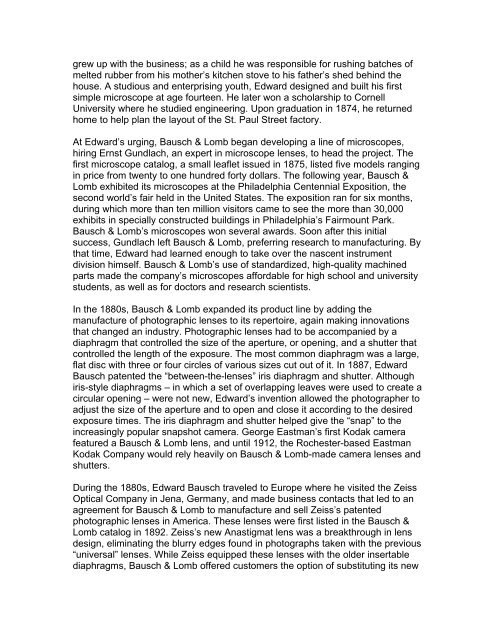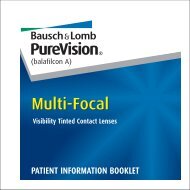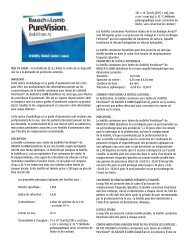Bausch & Lomb Perfecting vision, enhancing life for 150 years A ...
Bausch & Lomb Perfecting vision, enhancing life for 150 years A ...
Bausch & Lomb Perfecting vision, enhancing life for 150 years A ...
Create successful ePaper yourself
Turn your PDF publications into a flip-book with our unique Google optimized e-Paper software.
grew up with the business; as a child he was responsible <strong>for</strong> rushing batches of<br />
melted rubber from his mother’s kitchen stove to his father’s shed behind the<br />
house. A studious and enterprising youth, Edward designed and built his first<br />
simple microscope at age fourteen. He later won a scholarship to Cornell<br />
University where he studied engineering. Upon graduation in 1874, he returned<br />
home to help plan the layout of the St. Paul Street factory.<br />
At Edward’s urging, <strong>Bausch</strong> & <strong>Lomb</strong> began developing a line of microscopes,<br />
hiring Ernst Gundlach, an expert in microscope lenses, to head the project. The<br />
first microscope catalog, a small leaflet issued in 1875, listed five models ranging<br />
in price from twenty to one hundred <strong>for</strong>ty dollars. The following year, <strong>Bausch</strong> &<br />
<strong>Lomb</strong> exhibited its microscopes at the Philadelphia Centennial Exposition, the<br />
second world’s fair held in the United States. The exposition ran <strong>for</strong> six months,<br />
during which more than ten million visitors came to see the more than 30,000<br />
exhibits in specially constructed buildings in Philadelphia’s Fairmount Park.<br />
<strong>Bausch</strong> & <strong>Lomb</strong>’s microscopes won several awards. Soon after this initial<br />
success, Gundlach left <strong>Bausch</strong> & <strong>Lomb</strong>, preferring research to manufacturing. By<br />
that time, Edward had learned enough to take over the nascent instrument<br />
di<strong>vision</strong> himself. <strong>Bausch</strong> & <strong>Lomb</strong>’s use of standardized, high-quality machined<br />
parts made the company’s microscopes af<strong>for</strong>dable <strong>for</strong> high school and university<br />
students, as well as <strong>for</strong> doctors and research scientists.<br />
In the 1880s, <strong>Bausch</strong> & <strong>Lomb</strong> expanded its product line by adding the<br />
manufacture of photographic lenses to its repertoire, again making innovations<br />
that changed an industry. Photographic lenses had to be accompanied by a<br />
diaphragm that controlled the size of the aperture, or opening, and a shutter that<br />
controlled the length of the exposure. The most common diaphragm was a large,<br />
flat disc with three or four circles of various sizes cut out of it. In 1887, Edward<br />
<strong>Bausch</strong> patented the “between-the-lenses” iris diaphragm and shutter. Although<br />
iris-style diaphragms – in which a set of overlapping leaves were used to create a<br />
circular opening – were not new, Edward’s invention allowed the photographer to<br />
adjust the size of the aperture and to open and close it according to the desired<br />
exposure times. The iris diaphragm and shutter helped give the “snap” to the<br />
increasingly popular snapshot camera. George Eastman’s first Kodak camera<br />
featured a <strong>Bausch</strong> & <strong>Lomb</strong> lens, and until 1912, the Rochester-based Eastman<br />
Kodak Company would rely heavily on <strong>Bausch</strong> & <strong>Lomb</strong>-made camera lenses and<br />
shutters.<br />
During the 1880s, Edward <strong>Bausch</strong> traveled to Europe where he visited the Zeiss<br />
Optical Company in Jena, Germany, and made business contacts that led to an<br />
agreement <strong>for</strong> <strong>Bausch</strong> & <strong>Lomb</strong> to manufacture and sell Zeiss’s patented<br />
photographic lenses in America. These lenses were first listed in the <strong>Bausch</strong> &<br />
<strong>Lomb</strong> catalog in 1892. Zeiss’s new Anastigmat lens was a breakthrough in lens<br />
design, eliminating the blurry edges found in photographs taken with the previous<br />
“universal” lenses. While Zeiss equipped these lenses with the older insertable<br />
diaphragms, <strong>Bausch</strong> & <strong>Lomb</strong> offered customers the option of substituting its new






